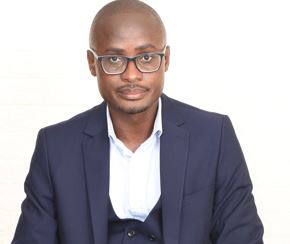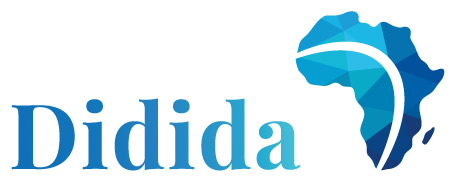AI-Powered Malaria Diagnostics: How Real-World Innovation in Kenya is Shaping the Future of Connected Health in Africa
In many parts of sub-Saharan Africa, malaria remains one of the most persistent public health challenges — a disease that not only claims lives but also strains fragile health systems. As the world races toward digital transformation, one question has taken center stage: can artificial intelligence help health workers diagnose and report malaria more accurately, faster, and at scale?

Felix Bahati, PhD student, KEMRI, Kenya
A new study led by Felix Bahati, a PhD student supported by the Didida Project, provides a compelling answer. Published in BMC Digital Health (2025), his research demonstrates that an AI-powered system for interpreting malaria rapid diagnostic tests (mRDTs) can achieve expert-level accuracy when deployed in real clinical settings. Beyond the technology, it shows how connected diagnostics can transform disease surveillance, empower local health workers, and strengthen health systems from the ground up.
The Challenge: Doing More with Less
Across Africa, health systems face mounting pressures: population growth, urbanization, climate change, and the spread of antimicrobial resistance. These overlapping crises — highlighted by the PharmAccess Foundation in Kenya, one of the Didida project partners — reveal a stark reality: “we have to do more with less.”
Public resources are stretched, and traditional disease reporting systems often rely on retrospective, incomplete data. In counties like Kisumu in western Kenya, health officials long struggled to understand where malaria cases were concentrated or how the disease evolved week by week.
“The main malaria challenge we had as a county was getting data — and being able to use it at the right time to make decisions. We just used to key in data from the community unit level, but we were not able to visualize where malaria was concentrated.”
Adding to the problem, roughly half of all malaria services in Kenya are delivered by private providers, yet their data rarely feed into national systems. This blind spot hampers timely, data-driven interventions and leaves decision-makers reacting rather than anticipating outbreaks.
A New Approach: AI Meets Connected Diagnostics
Felix Bahati’s study was part of the collaboration between PharmAccess Foundation, Kisumu County Government, and other partners. The initiative sought to address these challenges through a digital ecosystem that links malaria testing, AI interpretation, and real-time data visualization.
At the core of this system is an AI model embedded within the HealthPulse app. Here’s how it works:
- A health worker — whether at a public clinic, private pharmacy, or community health post — performs a standard malaria rapid diagnostic test (mRDT).
- Using the HealthPulse smartphone app, the worker captures an image of the test cassette.
- The AI model automatically analyzes the image, determining whether the test is positive, negative, or invalid.
- Results are uploaded to a secure server and displayed on a geo-mapped digital dashboard, available to county health authorities in near real time.
This process ensures quality control, reduces interpretation errors, and most importantly, generates live epidemiological data instead of end-of-month reports.
The Study: Real-World Evidence from Kisumu
In his BMC Digital Health article, Felix Bahati and colleagues conducted a rigorous field evaluation of the innovation in five health facilities across Kisumu County, Kenya. The study analyzed 3,620 malaria rapid diagnostic tests performed by local health workers and interpreted both by humans and by the AI system.
The results were striking:
- Weighted F1 score: 0.975
- Cohen’s Kappa: 0.92 (near-perfect agreement with human experts)
- Sensitivity: 96.1%
- Specificity: 98.0%
- No statistically significant difference between human and AI interpretations.
In other words, the AI was just as good as expert laboratory staff at identifying malaria test results — but much faster, consistent, and scalable.
Beyond performance metrics, the study also measured the feasibility, usability, and acceptability of the system among health workers. Feedback was overwhelmingly positive: users found the app intuitive and helpful, and several reported increased confidence in performing and interpreting tests.
Transforming Everyday Health Work
The success of the Connected Diagnostics model goes far beyond algorithmic accuracy. It changes how healthcare operates on the ground.
Community health promoters — often the first point of contact for patients in rural or peri-urban areas — can now test, record, and refer without delay. Private pharmacists, previously excluded from official reporting, can now contribute valuable data. And county health authorities finally gain access to a comprehensive, real-time overview of malaria trends across all sectors.
“Having an application that uses artificial intelligence to identify malaria cases and make decisions at the lower level has really helped us capture more cases… It has integrated the private and public systems, giving us a holistic view of malaria in our region.”
The system also incentivizes best practice — workers receive small data bundles or mobile money for each correctly uploaded test — reinforcing accurate reporting and test-before-treat behaviour.
“When you give them a little incentive, they are motivated to test first. If they are testing first, then they are not shooting in the dark — they are treating what they know.”
A Bottom-Up Model for Health System Resilience
The innovation’s success lies in its bottom-up approach. Rather than imposing a centralized system, the project built trust and ownership among field workers, facility staff, and local government.
Data from the HealthPulse app feed directly into a semi-real-time, geo-mapped dashboard, allowing supervisors to monitor community health units, identify hotspots, and deploy interventions quickly.
“At our Public Health Emergency Operations Centre… we want to see the disease trends every morning — to know where to intervene immediately.”
This model proved not only technically feasible but also socially sustainable. It demonstrated that digital and AI-enabled systems can work at scale in resource-constrained environments, as long as they are built collaboratively and locally.
The impact on communities was tangible. Patients reported faster access to care, reduced travel time, and greater trust in local health promoters. Private providers gained recognition and accountability. And health administrators finally had data they could act on in real time — an essential factor for epidemic preparedness.
Beyond Malaria: A Blueprint for Health Systems of the Future
While the pilot focused on malaria, the principles behind Connected Diagnostics can apply to many diseases. The combination of AI interpretation, mobile connectivity, and real-time surveillance can be extended to other infectious diseases — and even non-communicable ones.
The approach also offers an antidote to the fragmentation that has long plagued African health systems. Instead of separate silos for public and private providers, Connected Diagnostics creates a unified digital backbone, enabling governments to coordinate responses efficiently and equitably.
“We want to be paperless. We want to make decisions almost daily, almost instantly. We don’t want anyone dying from malaria just because decisions were delayed.”
This mindset — data-driven, decentralized, and proactive — is exactly what the Didida Project aims to scale across the continent.
From single disease diagnostics to Didida: Building the Multiplexe Diagnostic Devices
The Didida Project, co-funded by Horizon Europe and UK Research & Innovation (UKRI), takes the lessons from Connected Diagnostics and expands them into a new frontier of locally manufactured, multiplexed diagnostic technologies.
While the initial research focused on AI interpretation of malaria rapid tests, Didida goes further by developing an integrated diagnostic device capable of detecting multiple diseases simultaneously from a single sample — an evolution beyond conventional lateral flow tests.
| Felix’s study | Didida Project (Next Step) |
|---|---|
| Focused on malaria mRDTs | Detects multiple infectious & non-communicable diseases |
| Used HealthPulse app for AI interpretation | Will integrate AI-powered result reading into a dedicated mobile app |
| Data visualized on a county dashboard | Results connected to national DHIS2 systems for real-time policy decisions |
| Proof of concept for AI reliability in low-resource settings | Scalable, open-source diagnostic ecosystem manufactured locally in Africa |
The Didida device will function like a portable PCR, using DNA-based detection, enabling high accuracy at the point of care. When paired with its mobile application, it will automatically send anonymized results to secure government-owned databases, interpret outcomes using AI models, and display aggregated trends on a public-health dashboard for ministries.
Just as in the Kisumu pilot, the system emphasizes data sovereignty, security, and local ownership — but this time, at continental scale.
Empowering Local Manufacturing and Knowledge
One of Didida’s most transformative goals is to build manufacturing capacity in Africa. By supporting local production of diagnostic tools, the project reduces dependency on imports and ensures that technologies are adapted to real-world contexts.
This aligns directly with the spirit of Felix Bahati’s work: innovation that emerges from the field, for the field. By proving that AI diagnostics can thrive in Kenya’s local clinics and pharmacies, his study lays the scientific foundation for Didida’s distributed innovation model — where digital tools, data platforms, and diagnostic devices co-evolve in synergy.
As the Didida consortium advances this technology, it will integrate AI components like ConnDx into its broader architecture — turning malaria diagnostics into just one module within a multi-disease connected health ecosystem.
A Human-Centered Vision
Beyond technology and data, both Didida shares a human story: one of trust, empowerment, and equity.
The community health promoters in Kisumu who now confidently test their neighbors are not just data points; they are symbols of what happens when innovation meets accessibility. Patients who once lost a full day traveling to hospitals can now get tested within minutes in their own villages. And policymakers who once waited weeks for reports can now act on real-time evidence.
These outcomes redefine what “digital health” means in practice. It’s not about apps or algorithms alone; it’s about creating feedback loops between citizens, caregivers, and authorities — where everyone contributes to, and benefits from, a shared data ecosystem.
Scaling the Proof of Concept
The Kisumu pilot delivered a proof of concept that connected, AI-enabled malaria testing is feasible and impactful. The next challenge — and Didida’s mission — is to bring this model to scale across Africa, adapting it to different diseases, infrastructure levels, and governance systems.
- Integrating digital diagnostics into national surveillance platforms like DHIS2.
- Ensuring open standards for interoperability.
- Training health workers and engineers in AI, data management, and quality assurance.
- Supporting local entrepreneurs and manufacturers who can maintain and evolve these tools long after project funding ends.
Ultimately, this is about resilience — not just in the face of malaria, but of all health threats that Africa’s rapidly changing environment presents.
A Shared Future for Digital Health in Africa
The lessons from Felix Bahati’s study and the Kisumu pilot are clear:
- AI can perform at expert level in real-world health facilities.
- Digital connectivity bridges gaps between private and public health sectors.
- Data ownership and local trust are critical for sustainability.
- Small incentives and human-centered design can shift health behaviors at scale.
These insights will guide Didida as it builds the next generation of diagnostics — smarter, faster, and made in Africa.
“Malaria is still a huge problem… We need radically different approaches — and Connected Diagnostics is one of them.”
The Didida Project embraces that vision — turning it into a continental movement for connected, ethical, and sovereign health innovation.
About the Research
Title: “Real-world evaluation of an AI-powered malaria diagnostic system in Kenyan health facilities”
Author: Felix Bahati, et al.
Published in: BMC Digital Health, 2025
Access: Read the paper
About Didida
Didida (Developing Integrated Diagnostics for Africa) is a five-year, €8-million research and innovation project funded by Horizon Europe and UK Research & Innovation, coordinated by Innotrope. The project brings together 14 partners from four African and four European countries to design and locally manufacture affordable, AI-enabled diagnostic technologies for multiple infectious and non-communicable diseases.
Learn more: didida-health.eu
Want to know more?
Are you a student and you want to learn more? A researcher seeking to consult our publications? A citizen eager to better understand the issues? A decision-maker who can promote this innovation? A journalist looking for an engaging story to tell?
